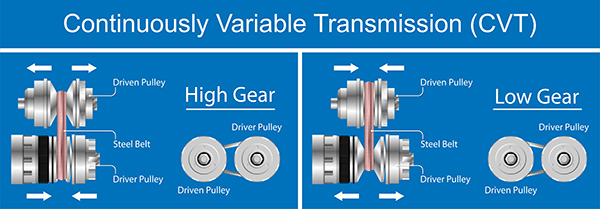
The world of automotive engineering is constantly evolving, bringing forth innovative technologies designed to enhance the driving experience. One such advancement is the Continuously Variable Transmission (CVT). Unlike traditional transmissions, CVTs offer a seamless driving experience, but how exactly do they work? We'll explore the mechanics of CVTs and discover why they are becoming increasingly popular in modern vehicles.
The Basics of CVT
At its core, a Continuously Variable Transmission differs significantly from conventional automatic transmissions. Traditional transmissions use a fixed number of gears to deliver power from the engine to the wheels. In contrast, a CVT doesn't rely on a set number of gears. Instead, it uses a system of belts and pulleys to create an infinite number of gear ratios.
How It Works
Imagine riding a bicycle with gears. Instead of shifting between a set number of gears, imagine you had a continuously variable gear system that smoothly transitioned between gear ratios. This is essentially how a CVT operates. It adjusts the diameter of the pulleys, which changes the gear ratio on the fly, providing a smooth and efficient power delivery.
Components of a CVT
To understand how a CVT works, let's break down its primary components:
- Primary Pulley: Connected to the engine, this pulley adjusts its diameter to increase or decrease the gear ratio.
- Secondary Pulley: Connected to the drive shaft, this pulley works in conjunction with the primary pulley to transfer power to the wheels.
- Belt: The belt connects the primary and secondary pulleys. As the pulleys change diameters, the belt moves up and down the sides of the pulleys to adjust the gear ratio.
- Control System: This electronic system manages the adjustment of the pulleys to ensure optimal performance and efficiency.
Advantages of a CVT
Why are CVTs gaining popularity? Here are some of the key benefits:
Fuel Efficiency
One of the most significant advantages of a CVT is its ability to optimize engine performance, which can lead to improved fuel efficiency. By continuously adjusting the gear ratio, a CVT keeps the engine operating at its most efficient RPM, which saves fuel.
Smooth Driving Experience
Unlike traditional transmissions, which can sometimes feel jerky when shifting gears, a CVT provides a smooth and seamless driving experience. This is particularly noticeable during acceleration, where there are no discernible gear changes.
Improved Performance
CVTs can deliver power more effectively than traditional transmissions. Continuously adjusting the gear ratio ensures that the engine operates within its optimal power band, which can enhance acceleration and overall performance.
Common Misconceptions About CVTs
Despite their advantages, CVTs often face some skepticism. Let's address a few common misconceptions:
Durability Concerns
Early CVTs had some issues with durability, but modern CVTs have significantly improved. Advances in technology and materials have enhanced their reliability and lifespan.
Lack of Control
Some drivers feel that CVTs offer less control than manual or traditional automatic transmissions. However, many modern CVTs come with manual mode options that allow drivers to simulate gear shifts, providing a more engaging driving experience.
High Repair Costs
While it's true that CVTs can be expensive to repair, they are designed to require less maintenance than traditional transmissions. With proper care and regular maintenance, a CVT can be a reliable and cost-effective option.
Maintaining Your CVT
Like any other part of your vehicle, maintaining your CVT is crucial to ensure its longevity and performance. Here are some maintenance tips:
Regular Fluid Changes
CVTs use a special type of transmission fluid. Regularly checking and changing this fluid is essential to keep the transmission running smoothly.
Avoid Overloading
Do not overload your vehicle, as this can cause undue stress on the CVT and other components.
Scheduled Inspections
Regularly scheduled inspections by a qualified mechanic can help identify potential issues before they become major problems. This can save you time and money in the long run.
Want to keep your transmission in top condition? Schedule a maintenance check with Transmission Hero today to ensure your vehicle is running at its best performance.